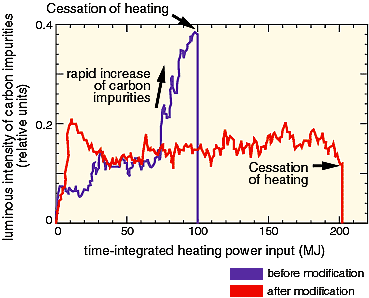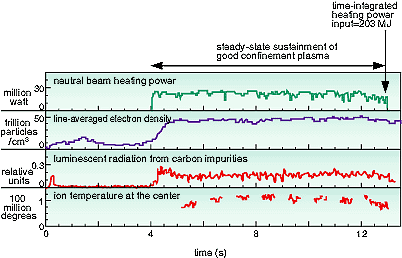To develop a method of maintaining high performance, steady-state
confinement of tokamak plasmas for a long time duration is the central
research program of JT-60. With the new, modified divertor, significant
progress was also made in the study of steady-state tokamak operation.
In JT-60, sustainment of a high performance, steady-state confinement
under high powered operation above 20 MW had been limited to about 3
s mainly due to the rapid increase in interactions between plasma particles
and the vessel wall and the influx of carbon impurities from the plasma
boundary. Plasma performance seriously deteriorated when the time-integrated
heating power input exceeds about 70 MJ.
In experiments with the new divertor, we clearly demonstrated the suppression
of the influx of carbon impurities and of neutral particles produced
near the divertor into the main plasma, and confirmed the effectiveness
of pumped divertor functions together with our design concept adopted
for the divertor modification. Figure 2-3 compares the carbon impurities
before and after divertor modification as a function of the time-integrated
heating power input, or heating power times heating time. As shown in
the figure, while the heating input is increased to values as large
as 200 MJ, the new divertor can keep the impurity contamination at a
moderately low level in marked contrast with earlier experiments with
the old divertor. As a result of the successful operation of the new
divertor, a good confinement plasma has been sustained for about 9 s
in a steady-state as shown in Fig. 2-4. The sustainment time was limited
by the marginal operational capacity of some of the JT-60 devices, not
by the impurity contamination.
Because of the development of the long sustainment of steady-state plasma
confinement in JT-60, experimental studies of the effect of the slow
time evolution of the plasma current distribution on steady-state plasma
confinement are now feasible and are expected in the near future. |

